lock Citroen C5 2016 (RD/TD) / 2.G Owner's Guide
[x] Cancel search | Manufacturer: CITROEN, Model Year: 2016, Model line: C5, Model: Citroen C5 2016 (RD/TD) / 2.GPages: 366, PDF Size: 30.93 MB
Page 99 of 366
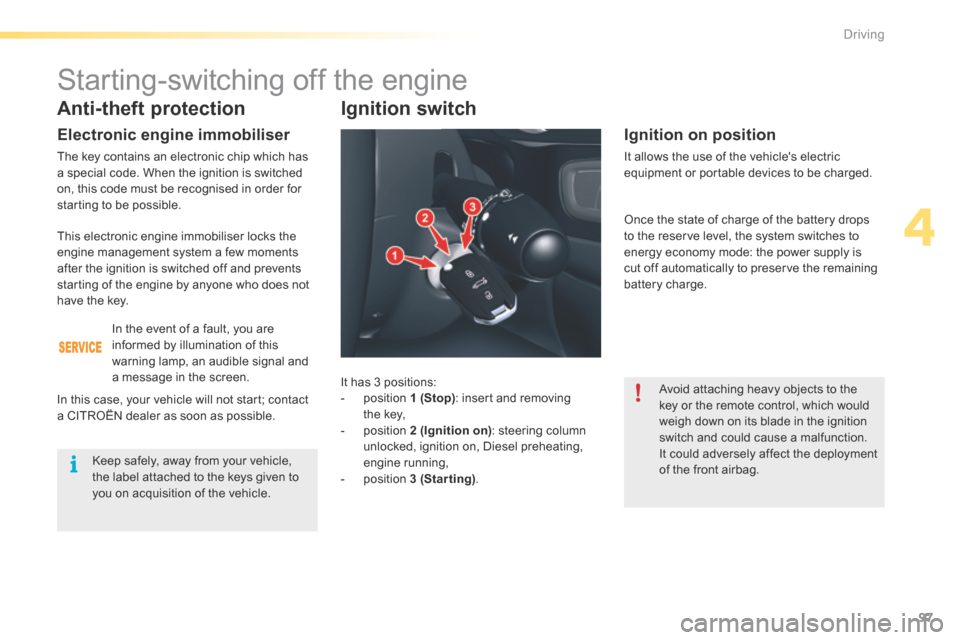
97
C5_en_Chap04_conduite_ed01-2015
Anti-theft protection
Electronic engine immobiliser
The key contains an electronic chip which has
a special code. When the ignition is switched
on, this code must be recognised in order for
starting to be possible.In the event of a fault, you are
informed by illumination of this
warning lamp, an audible signal and
a message in the screen.
In this case, your vehicle will not start; contact
a CITROËN dealer as soon as possible.
Starting-switching off the engine
Keep safely, away from your vehicle,
the label attached to the keys given to
you on acquisition of the vehicle.
Ignition switch
It has 3 positions:
- position 1 (Stop): insert and removing
the key,
- position 2 (Ignition on) : steering column
unlocked, ignition on, Diesel preheating,
engine running,
- position 3 (Starting).
Ignition on position
It allows the use of the vehicle's electric
equipment or portable devices to be charged.
Avoid attaching heavy objects to the
key or the remote control, which would
weigh down on its blade in the ignition
switch and could cause a malfunction.
It could adversely affect the deployment
of the front airbag.
This electronic engine immobiliser locks the
engine management system a few moments
after the ignition is switched off and prevents
starting of the engine by anyone who does not
have the key.
Once the state of charge of the battery drops
to the reserve level, the system switches to
energy economy mode: the power supply is
cut off automatically to preserve the remaining
battery charge.
4
Driving
Page 100 of 366
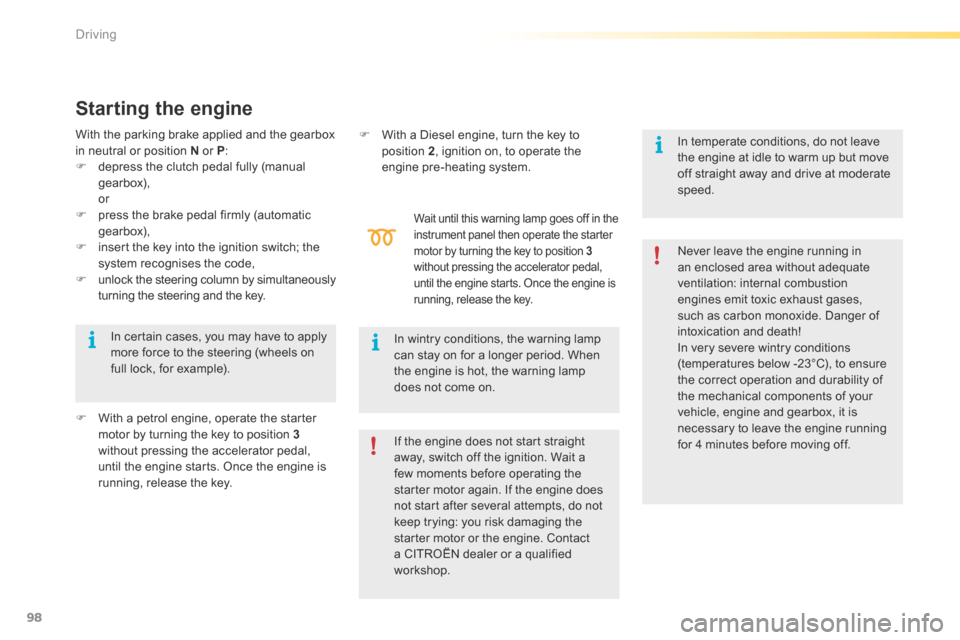
98
C5_en_Chap04_conduite_ed01-2015
Starting the engine
Wait until this warning lamp goes off in the
instrument panel then operate the starter
motor by turning the key to position 3
without pressing the accelerator pedal,
until the engine starts. Once the engine is
running, release the key.
With the parking brake applied and the gearbox
in neutral or position N or P:
F depress the clutch pedal fully (manual
gearbox),
or
F press the brake pedal firmly (automatic
gearbox),
F insert the key into the ignition switch; the
system recognises the code,
F unlock the steering column by simultaneously
turning the steering and the key.
F With a petrol engine, operate the starter
motor by turning the key to position 3
without pressing the accelerator pedal,
until the engine starts. Once the engine is
running, release the key. Never leave the engine running in
an enclosed area without adequate
ventilation: internal combustion
engines emit toxic exhaust gases,
such as carbon monoxide. Danger of
intoxication and death!
In very severe wintry conditions
(temperatures below -23°C), to ensure
the correct operation and durability of
the mechanical components of your
vehicle, engine and gearbox, it is
necessary to leave the engine running
for 4 minutes before moving off.
In wintry conditions, the warning lamp
can stay on for a longer period. When
the engine is hot, the warning lamp
does not come on.
In certain cases, you may have to apply
more force to the steering (wheels on
full lock, for example). F
With a Diesel engine, turn the key to
position 2 , ignition on, to operate the
engine pre-heating system.
If the engine does not start straight
away, switch off the ignition. Wait a
few moments before operating the
starter motor again. If the engine does
not start after several attempts, do not
keep trying: you risk damaging the
starter motor or the engine. Contact
a CITROËN dealer or a qualified
workshop. In temperate conditions, do not leave
the engine at idle to warm up but move
off straight away and drive at moderate
speed.
Driving
Page 101 of 366

99
C5_en_Chap04_conduite_ed01-2015
Do not flick the accelerator at the
moment of switching off the ignition.
This could cause serious damage to the
turbocharger(s).
Vehicles equipped with a
turbocharger
Never stop the engine without having allowed it
to run for a few seconds at idle, this being the
time required for the turbocharger to return to a
normal speed.Energy economy mode
After switching off the engine (position 1- Stop),
for a maximum of 30 minutes you can still use
functions such as the audio and telematic
system, the wipers, dipped beam headlamps,
courtesy lamps, ...
Switching off the engine
F Stop the vehicle.
F With the engine running at idle, turn the key
to position 1 .
F Remove the key from the ignition switch.
F To lock the steering column, turn the
steering until it locks.
When you leave the vehicle, keep the
key with you and lock the vehicle. To facilitate unlocking of the steering
column, it is recommended that the
wheels be returned to the straight ahead
position before switching off the engine.
Never switch off the ignition before the
vehicle is at a complete stop. With the
engine off, the braking and steering
assistance systems are also cut off: risk
of loss of control of the vehicle. For more information, refer to the
"Practical information" section, under
"Energy economy mode".
F Check that the parking brake is correctly
applied, particularly on sloping ground.
Key left in the "Ignition on"
position
On opening the driver's door, an alert
message is displayed, accompanied
by an audible signal, to remind you that
the key is still in the ignition switch at
position 1 (Stop) .
If the key has been left in the ignition
switch at position 2 (Ignition on) ,
the ignition will be switched off
automatically after one hour.
To switch the ignition back on, turn the
key to position 1 (Stop) , then back to
position 2 (Ignition on) .
4
Driving
Page 113 of 366

111
C5_en_Chap04_conduite_ed01-2015
Moving off
F To start the engine, the gear selector must
be in position P or N .
F Operate the starter.
F When the engine is running, place the gear
selector at R , D or M.
F Check in the instrument panel, the position
engaged.
F Release the brake pedal and accelerate.
F To avoid a possible difference between the
position of the gear selector and the actual
position of the gearbox, always come out
of position P with the ignition on and brake
pedal applied.
Otherwise, when the ignition is on or the engine
is running:
F reposition the gear selector at position P ,
F put your foot on the brake pedal and then
select the gear you want.
Park
This position of the gear selector
is used to prevent the vehicle from
moving when you are stationary.
Reverse gear
Only engage this position when the
vehicle is stationary. To prevent
snatching, do not accelerate too soon
after selection.
Neutral
never select position N if the vehicle
is moving.
F
To select position P , move the gear selector
back to the highest position (towards R ),
then push it for wards and then to the left.
F To exit position P, move the gear selector to
the right and then to the position you want.
F Only engage this position when the vehicle
is completely stationary. In this position,
the front wheels are locked. Make sure that
the gear selector is correctly positioned.
never select position P or R if the
vehicle is not stationary.
If, while the vehicle is moving,
position N is engaged inadvertently,
allow the engine to idle before engaging
position D or M .
4
Driving
Page 115 of 366
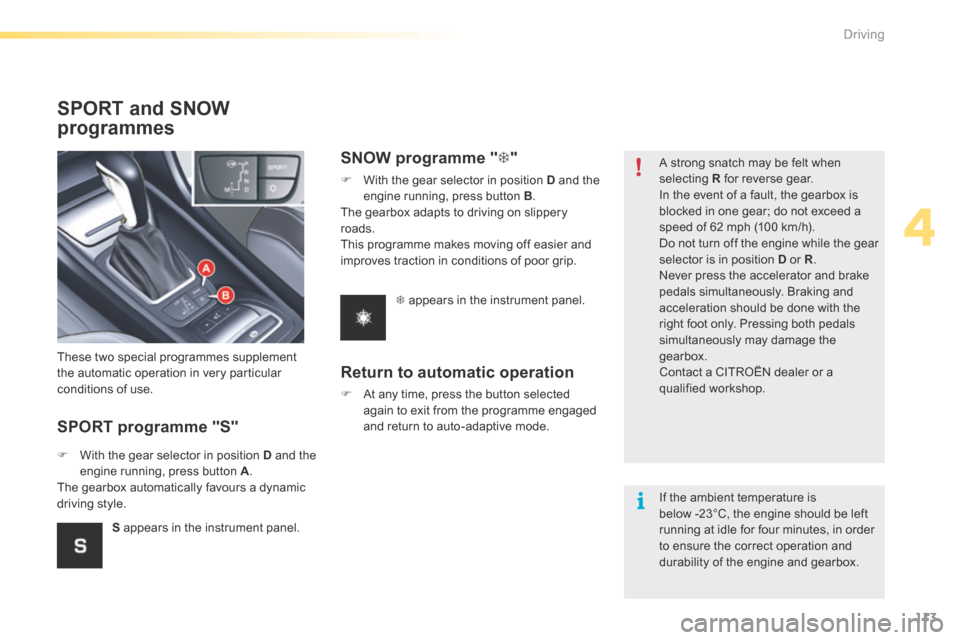
113
C5_en_Chap04_conduite_ed01-2015
SPORT and SNOW
programmes
SPORT programme "S"
These two special programmes supplement
the automatic operation in very particular
conditions of use.
F With the gear selector in position D and the
engine running, press button A .
The gearbox automatically favours a dynamic
driving style.
SNOW programme " T"
F With the gear selector in position D and the
engine running, press button B .
The gearbox adapts to driving on slippery
roads.
This programme makes moving off easier and
improves traction in conditions of poor grip.
T appears in the instrument panel.
S appears in the instrument panel.
Return to automatic operation
F At any time, press the button selected
again to exit from the programme engaged
and return to auto-adaptive mode. A strong snatch may be felt when
selecting
R for reverse gear.
In the event of a fault, the gearbox is
blocked in one gear; do not exceed a
speed of 62 mph (100 km/h).
Do not turn off the engine while the gear
selector is in position D or R .
Never press the accelerator and brake
pedals simultaneously. Braking and
acceleration should be done with the
right foot only. Pressing both pedals
simultaneously may damage the
gearbox.
Contact a CITR oËn dealer or a
qualified workshop.
If the ambient temperature is
below -23°C, the engine should be left
running at idle for four minutes, in order
to ensure the correct operation and
durability of the engine and gearbox.
4
Driving
Page 133 of 366

131
C5_en_Chap04_conduite_ed01-2015
Parking sensors
Operation
The parking sensors system cannot, in
any circumstances, replace the need for
vigilance on the part of the driver.
This system detects any obstacle (person,
vehicle, tree, barrier...) located in front of or
behind the vehicle, however, it will not be able
to detect obstacles located immediately below
the bumper.
An object, such as a stake, a roadworks cone
or any other similar object may be detected at
the start of the manoeuvre but may no longer
be detected when the vehicle moves nearer
to it.
At the front and/or at the rear
This system is comprised of proximity sensors,
installed in the front and/or rear bumper.
Visual and audible assistance
The proximity information is indicated by:
-
an audible signal which becomes more rapid
as the vehicle approaches the obstacle,
- a diagram in the multifunction screen, with
blocks which move closer to the vehicle.
The obstacle is located in relation to the emission
of the audible signal by the speakers; front or rear
and right or left.
When the distance between the vehicle and
the obstacle is less than approximately thirty
centimetres, the audible signal becomes
continuous and/or the "Danger" symbol appears,
depending on the multifunction screen version.
In bad weather or in winter, ensure
that the sensors are not covered with
mud, ice or snow. When reverse gear is
engaged, an audible signal (long beep)
indicates that the sensors may be dirty.
When the speed of the vehicle is below
about 6 mph (10 km/h), some sources
of noise (motorcycle, lorry, pneumatic
drill, ...) may trigger the audible parking
sensor signals. The parking sensors are switched on
:
- by engaging reverse gear,
- at a speed below 6 mph (10 km/h) in
forward gear.
This is accompanied by an audible signal and
the display of the vehicle in the multifunction
screen.
The parking sensors are switched off :
- when you exit reverse gear,
- when the speed is higher than 6 mph
(10 km/h) in for ward gear,
- when the vehicle has been stationary for
more than three seconds in for ward gear.
4
Driving
Page 152 of 366
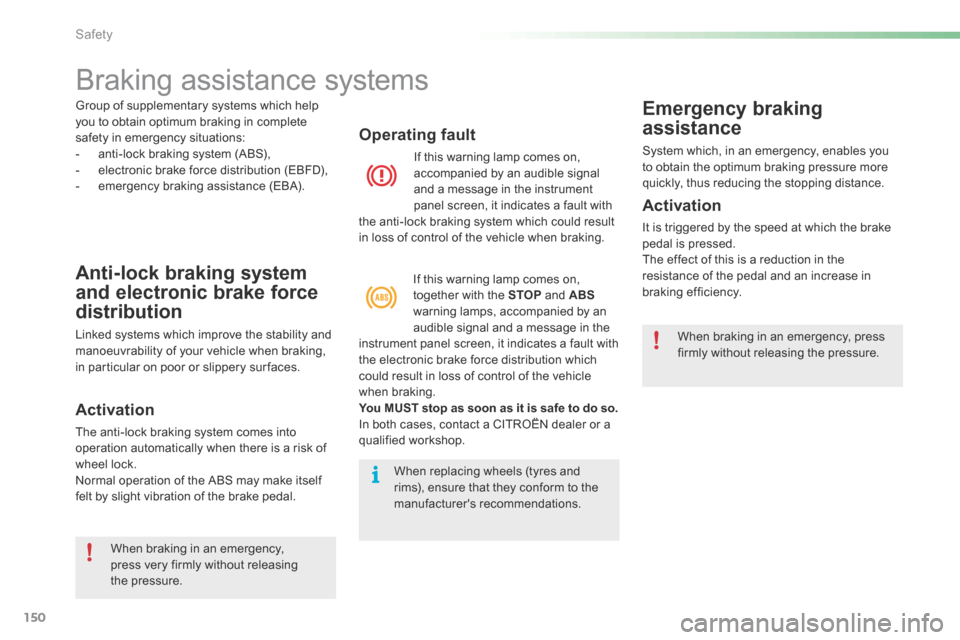
150
C5_en_Chap06_securite_ed01-2015
Braking assistance systems
Anti-lock braking system
and electronic brake force
distribution
Linked systems which improve the stability and
manoeuvrability of your vehicle when braking,
in particular on poor or slippery sur faces.
Activation
The anti-lock braking system comes into
operation automatically when there is a risk of
wheel lock.
Normal operation of the ABS may make itself
felt by slight vibration of the brake pedal.
Operating fault
If this warning lamp comes on,
accompanied by an audible signal
and a message in the instrument
panel screen, it indicates a fault with
the anti-lock braking system which could result
in loss of control of the vehicle when braking.
If this warning lamp comes on,
together with the STOP and ABS
warning lamps, accompanied by an
audible signal and a message in the
instrument panel screen, it indicates a fault with
the electronic brake force distribution which
could result in loss of control of the vehicle
when braking.
You MUST stop as soon as it is safe to do so.
In both cases, contact a CITR oËn dealer or a
qualified workshop.
Emergency braking
assistance
System which, in an emergency, enables you
to obtain the optimum braking pressure more
quickly, thus reducing the stopping distance.
Activation
It is triggered by the speed at which the brake
pedal is pressed.
The effect of this is a reduction in the
resistance of the pedal and an increase in
braking efficiency.
Group of supplementary systems which help
you to obtain optimum braking in complete
safety in emergency situations:
-
anti-lock braking system (ABS),
- electronic brake force distribution (EBFD),
- emergency braking assistance (EBA).
When replacing wheels (tyres and
rims), ensure that they conform to the
manufacturer's recommendations.When braking in an emergency, press
firmly without releasing the pressure.
When braking in an emergency,
press very firmly without releasing
the pressure.
Safety
Page 156 of 366
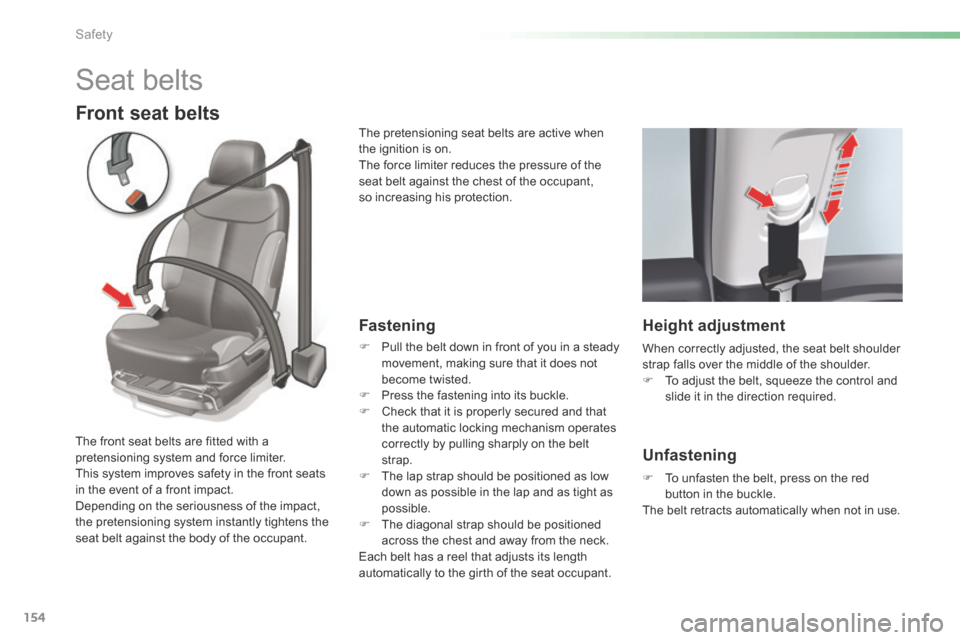
154
C5_en_Chap06_securite_ed01-2015
Seat belts
Front seat belts
Fastening
F Pull the belt down in front of you in a steady
movement, making sure that it does not
become twisted.
F Press the fastening into its buckle.
F Check that it is properly secured and that
the automatic locking mechanism operates
correctly by pulling sharply on the belt
strap.
F The lap strap should be positioned as low
down as possible in the lap and as tight as
possible.
F The diagonal strap should be positioned
across the chest and away from the neck.
Each belt has a reel that adjusts its length
automatically to the girth of the seat occupant.
The front seat belts are fitted with a
pretensioning system and force limiter.
This system improves safety in the front seats
in the event of a front impact.
Depending on the seriousness of the impact,
the pretensioning system instantly tightens the
seat belt against the body of the occupant. The pretensioning seat belts are active when
the ignition is on.
The force limiter reduces the pressure of the
seat belt against the chest of the occupant,
so increasing his protection.
Height adjustment
When correctly adjusted, the seat belt shoulder
strap falls over the middle of the shoulder.
F
To adjust the belt, squeeze the control and
slide it in the direction required.
Unfastening
F To unfasten the belt, press on the red
button in the buckle.
The belt retracts automatically when not in use.
Safety
Page 158 of 366
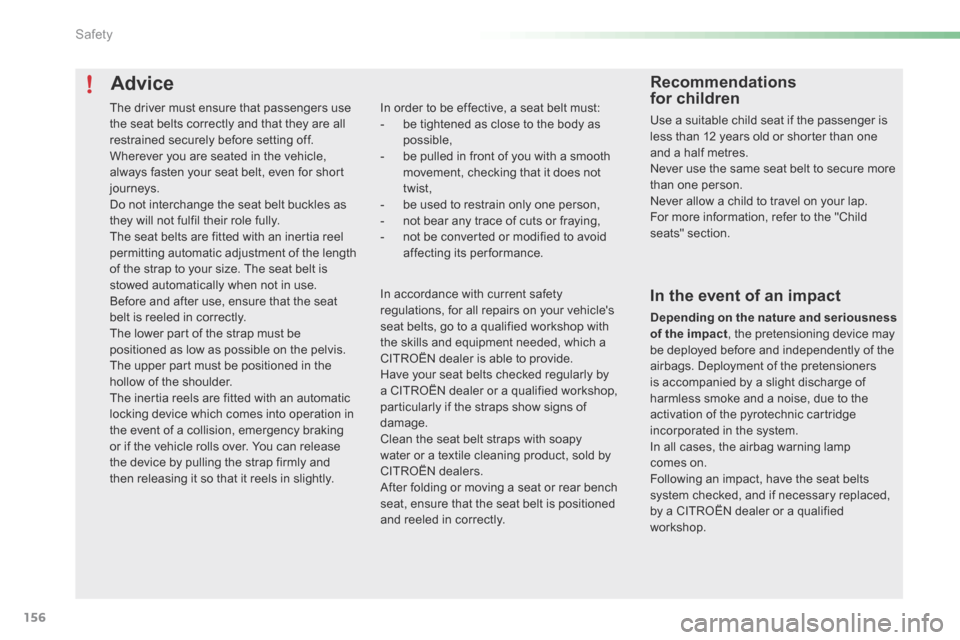
156
C5_en_Chap06_securite_ed01-2015
Advice
In order to be effective, a seat belt must:
- be tightened as close to the body as
possible,
- be pulled in front of you with a smooth
movement, checking that it does not
twist,
- be used to restrain only one person,
- not bear any trace of cuts or fraying,
- not be converted or modified to avoid
affecting its performance.
Recommendations
for children
Use a suitable child seat if the passenger is
less than 12 years old or shorter than one
and a half metres.
Never use the same seat belt to secure more
than one person.
Never allow a child to travel on your lap.
For more information, refer to the "Child
seats" section.
In accordance with current safety
regulations, for all repairs on your vehicle's
seat belts, go to a qualified workshop with
the skills and equipment needed, which a
CITROËN dealer is able to provide.
Have your seat belts checked regularly by
a CITROËN dealer or a qualified workshop,
particularly if the straps show signs of
damage.
Clean the seat belt straps with soapy
water or a textile cleaning product, sold by
CITROËN dealers.
After folding or moving a seat or rear bench
seat, ensure that the seat belt is positioned
and reeled in correctly.
In the event of an impact
Depending on the nature and seriousness
of the impact , the pretensioning device may
be deployed before and independently of the
airbags. Deployment of the pretensioners
is accompanied by a slight discharge of
harmless smoke and a noise, due to the
activation of the pyrotechnic cartridge
incorporated in the system.
In all cases, the airbag warning lamp
comes on.
Following an impact, have the seat belts
system checked, and if necessary replaced,
by a CITROËN dealer or a qualified
workshop.
The driver must ensure that passengers use
the seat belts correctly and that they are all
restrained securely before setting off.
Wherever you are seated in the vehicle,
always fasten your seat belt, even for short
journeys.
Do not interchange the seat belt buckles as
they will not fulfil their role fully.
The seat belts are fitted with an inertia reel
permitting automatic adjustment of the length
of the strap to your size. The seat belt is
stowed automatically when not in use.
b
efore and after use, ensure that the seat
belt is reeled in correctly.
The lower part of the strap must be
positioned as low as possible on the pelvis.
The upper part must be positioned in the
hollow of the shoulder.
The inertia reels are fitted with an automatic
locking device which comes into operation in
the event of a collision, emergency braking
or if the vehicle rolls over. You can release
the device by pulling the strap firmly and
then releasing it so that it reels in slightly.
Safety
Page 173 of 366
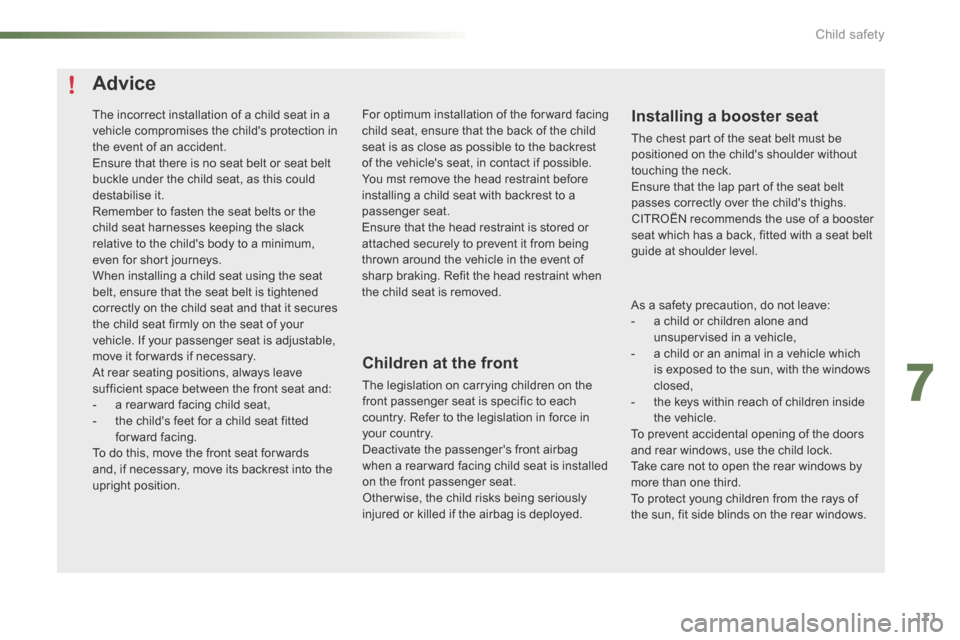
171
C5_en_Chap07_securite-enfant_ed01-2015
Advice
Children at the front
The legislation on carrying children on the
front passenger seat is specific to each
country. Refer to the legislation in force in
your country.
Deactivate the passenger's front airbag
when a rear ward facing child seat is installed
on the front passenger seat.
Otherwise, the child risks being seriously
injured or killed if the airbag is deployed.
Installing a booster seat
The chest part of the seat belt must be
positioned on the child's shoulder without
touching the neck.
Ensure that the lap part of the seat belt
passes correctly over the child's thighs.
CITROËN recommends the use of a booster
seat which has a back, fitted with a seat belt
guide at shoulder level.
The incorrect installation of a child seat in a
vehicle compromises the child's protection in
the event of an accident.
Ensure that there is no seat belt or seat belt
buckle under the child seat, as this could
destabilise it.
Remember to fasten the seat belts or the
child seat harnesses keeping the slack
relative to the child's body to a minimum,
even for short journeys.
When installing a child seat using the seat
belt, ensure that the seat belt is tightened
correctly on the child seat and that it secures
the child seat firmly on the seat of your
vehicle. If your passenger seat is adjustable,
move it for wards if necessary.
At rear seating positions, always leave
sufficient space between the front seat and:
-
a rear ward facing child seat,
- the child's feet for a child seat fitted
forward facing.
To do this, move the front seat for wards
and, if necessary, move its backrest into the
upright position. For optimum installation of the forward facing
child seat, ensure that the back of the child
seat is as close as possible to the backrest
of the vehicle's seat, in contact if possible.
You mst remove the head restraint before
installing a child seat with backrest to a
passenger seat.
Ensure that the head restraint is stored or
attached securely to prevent it from being
thrown around the vehicle in the event of
sharp braking. Refit the head restraint when
the child seat is removed.
As a safety precaution, do not leave:
- a child or children alone and
unsupervised in a vehicle,
- a child or an animal in a vehicle which
is exposed to the sun, with the windows
closed,
- the keys within reach of children inside
the vehicle.
To prevent accidental opening of the doors
and rear windows, use the child lock.
Take care not to open the rear windows by
more than one third.
To protect young children from the rays of
the sun, fit side blinds on the rear windows.
7
Child safety